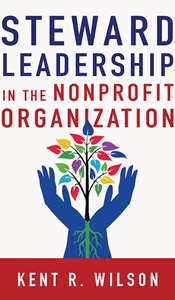Servant Leadership or Steward Leadership?
In "Steward Leadership in the Non-Profit Organization", Kent Wilson offers the concept of steward leadership as both more biblical and more appropriate than servant leadership
 For as long as I can remember, I’ve been taught that great leaders are servant leaders. Especially in the context of Christian ministry, servant leadership is often juxtaposed to a CEO-style of leadership and held up as the virtuous way for Christians to lead.
For as long as I can remember, I’ve been taught that great leaders are servant leaders. Especially in the context of Christian ministry, servant leadership is often juxtaposed to a CEO-style of leadership and held up as the virtuous way for Christians to lead.
The first time I was ever exposed to someone who explicitly stated that he didn’t like the term "servant leadership" was in a book by Duane Elmer titled Cross-Cultural Servanthood. Elmer was dissatisfied with the term for two reasons. First, many people who claim to be servant leaders aren’t. Second, we don’t create similar hybrids for other spiritual gifts in the church (i.e. servant-teacher, servant-helper, etc). Honestly, in spite of the fact that I’ve taught servant leadership myself over the years, I’ve never quite been satisfied with it either, though I couldn’t pinpoint why. I just figured it was probably the best way to explain how Christian leadership should work.
As it turns out, Duane Elmer and I aren’t the only two who feel this way. In Steward Leadership in the Non-Profit Organization, Kent Wilson offers the concept of steward leadership as both more biblical and more appropriate than servant leadership. And while he focuses his attention in this book on applying steward leadership to the non-profit sector, the principles are easily transferrable to the church and, to a somewhat lesser extent, for-profit businesses as well.
The first third of Wilson’s book looks at the role of the steward in biblical and historical perspective. While it’s a little tough sledding, it is academically interesting and an important foundation for the theory of steward leadership he proposes in the book’s second half. Quite frankly, after reading how much the Old and New Testaments discuss the steward’s role, and after reading a synopsis of Jesus’ own references to stewards in his parables, I wonder why this idea of stewardship is so new to us in the context of leadership.
The second half of Wilson’s argument is intensely practical. He outlines the differences between how servant leaders and steward leaders actually lead, and then shows how the many different individuals in an organization (CEO/executive, staff, boards, stakeholders, etc.) relate to one another within the scope of steward leadership.
With Wilson’s understanding that all stewards are servants, but not all servants are stewards, here are some of the primary ways he differentiates servant and steward leadership:
|
|
Servant Leadership |
Steward Leadership |
|
Strategy |
To ensure that other people’s highest-priority needs are being met and they develop as persons |
To achieve the objectives of the owner and stakeholders by managing people and resources for growth |
|
Core Identity |
Servant |
Steward |
|
Style of Leadership |
Participative |
Shifts between authoritarian and participative |
|
Motivation for Leadership |
Intrinsic: altruism (selfless pursuit of the interest of others), service to others |
Intrinsic: altruism, responsibility, respect for authority |
|
Characteristics |
Listening, empathy, healing, awareness, persuasion, conceptualization, foresight, stewardship, commitment, community |
Accountability, faithfulness, submissiveness, humility, knows the owner (relationship), mission focus, non-ownership, self-sacrifice, risk-taking |
|
Primary Action |
Serve people’s highest-priority needs; “servant first, leader second” |
Lead the organization to accomplish the desires and objectives of the owner and stakeholders, serve the owner and stakeholders, leverage and grow the resources |
|
Goal of Leadership |
Empowered followers |
Fulfilled mission, sustainable organization |
What may be most interesting to me about the roles of organizational leaders as defined by Wilson is the mutual interdependence he proposes, particularly between the top executive (or lead pastor in a local church) and the board. The general direction of local church governance (especially in new churches where church planters are crafting their own governance structures) is moving toward a pastor-centric leadership model where the board exists mostly to support the pastor’s vision.
But Wilson takes a very different approach. He actually places the organization’s board in the role of chief steward, the CEO/lead pastor in the role of understeward, God is the owner and he refers to the congregational members as implicit human owners.
The suggested division of responsibilities and guidelines for appropriate interaction between board and pastor are too detailed to outline here. I will say that it’s worth reading and that many pastors will be challenged by Wilson’s understanding of the board’s role as steward and the pastor’s role as understeward, especially since that’s not the norm in many evangelical churches.
What I most appreciate about Wilson’s explanation of the steward leadership model is his motivation, which seems to be authentically grounded in biblical principles. He wisely and carefully warns leaders against the slippery slope of an ownership mentality, an exhortation that leaders in Jesus’ church, regardless of position or role, should eagerly heed.
Book Reviewed: Kent R. Wilson, Steward Leadership in the Non-Profit Organization. (Downers Grove, IL: IVP Academic, 2016)
Influence Magazine & The Healthy Church Network
© 2025 Assemblies of God

